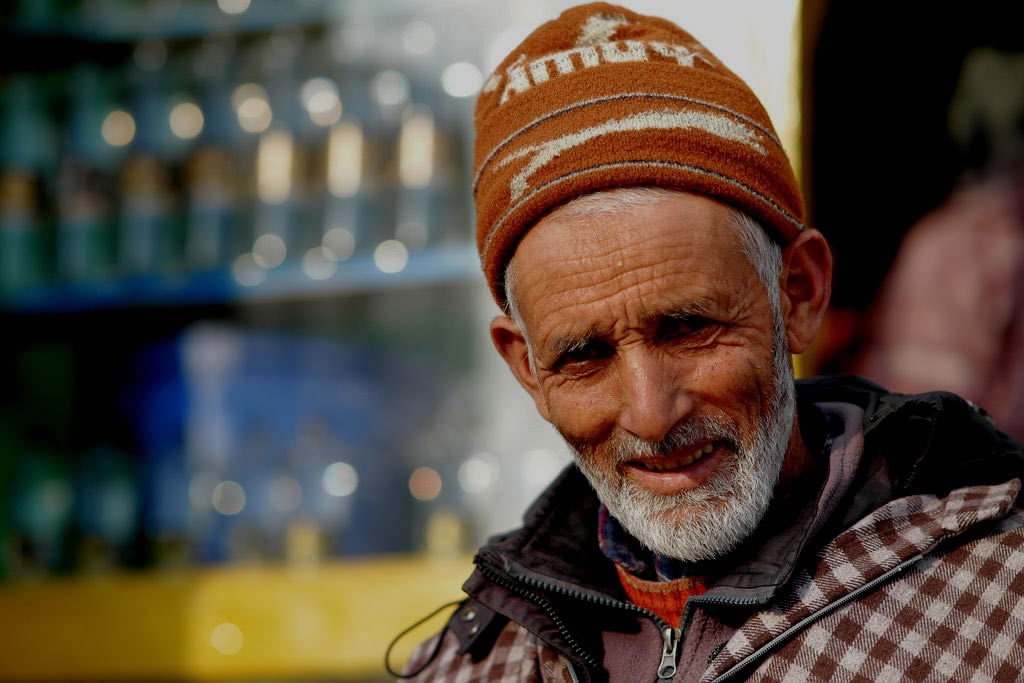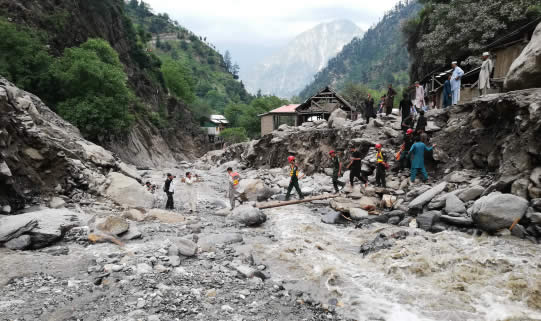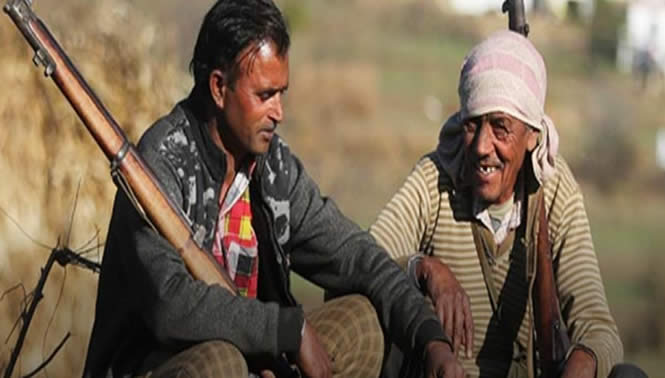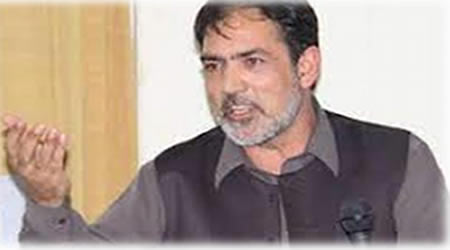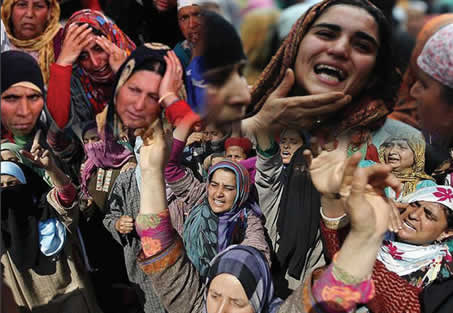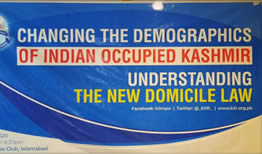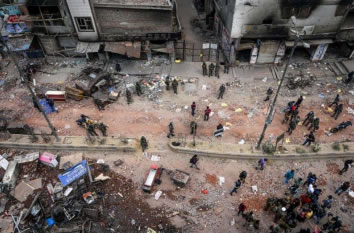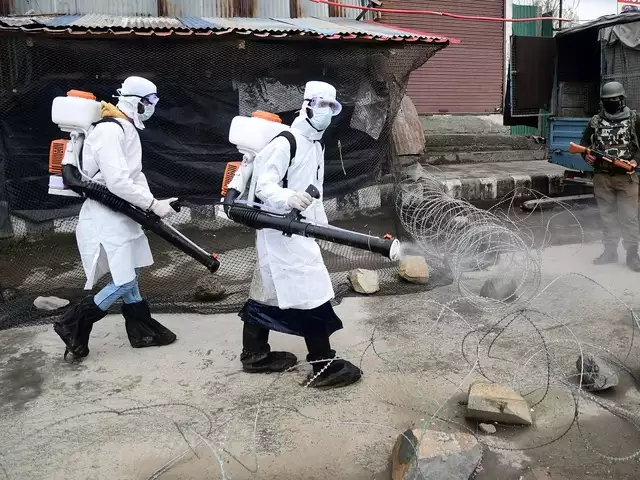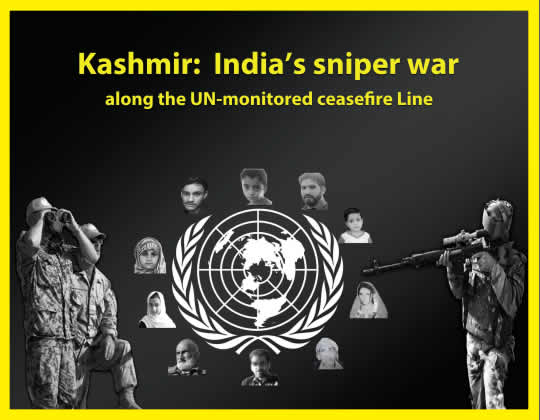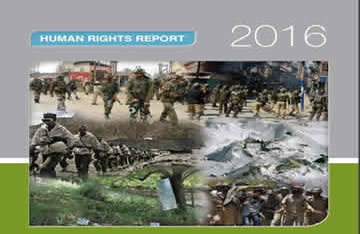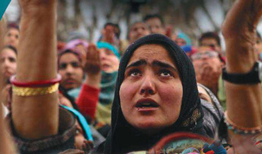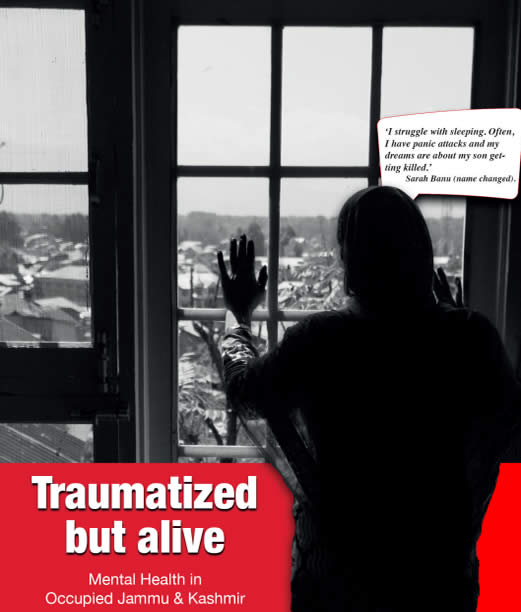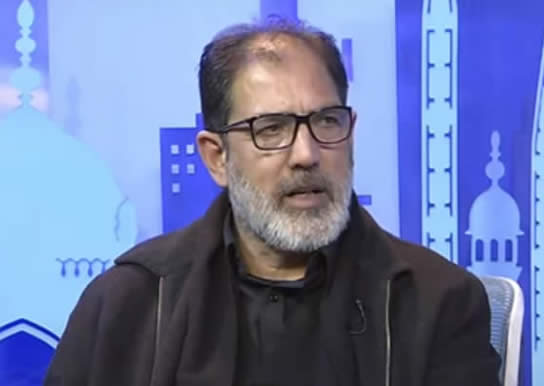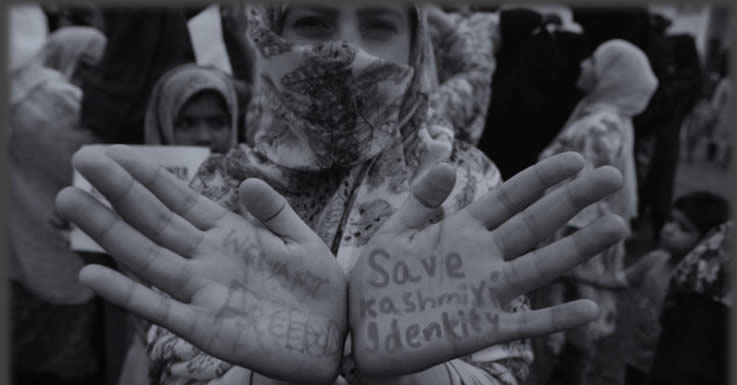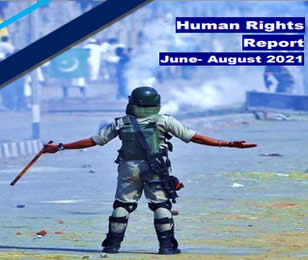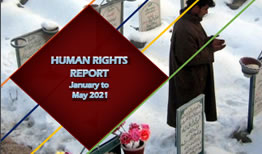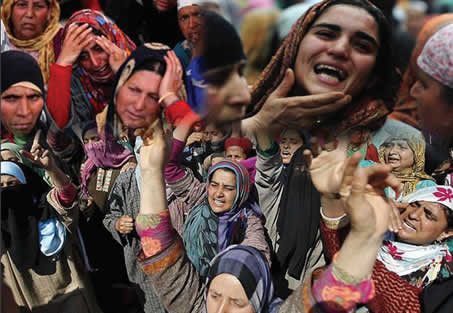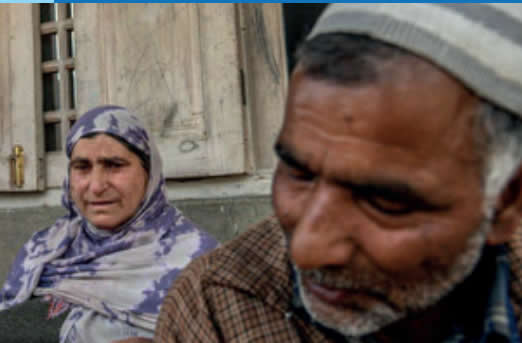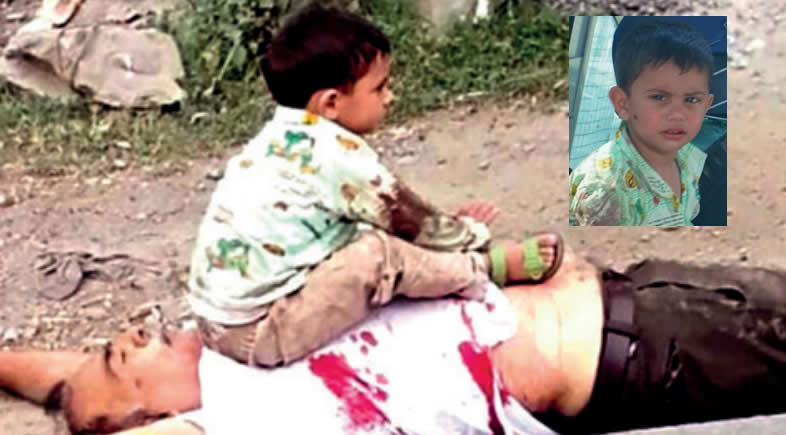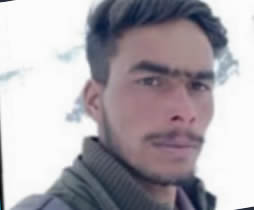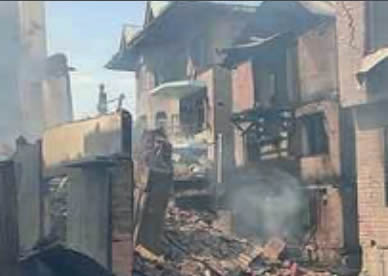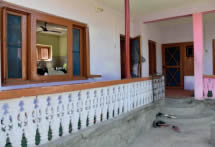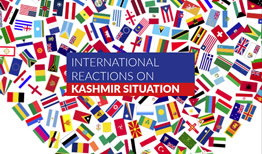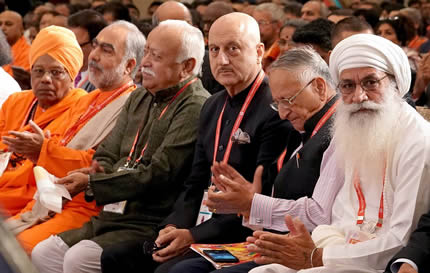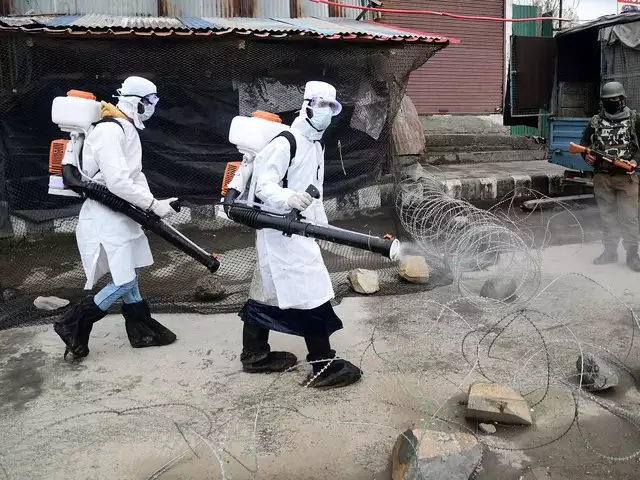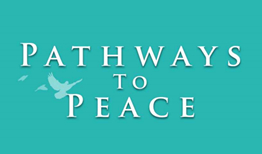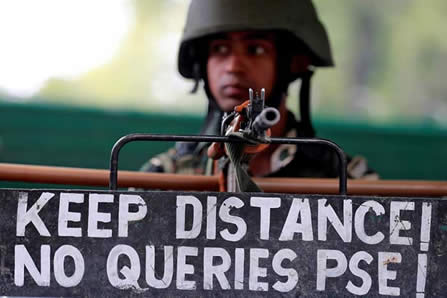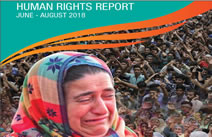EXPLOITATION & POLITICS OF LAND GRABBING IN IOK
Background
The year 1989 marks the beginning of an armed struggle in Kashmir, which within a short span of time took the form of a full-grown statewide mass uprising attracting people hailing from different strata of the society particularly the youth who readily joined the resistance movement with a benevolent intention to liberate their homeland from the clutches of Indian occupation. The freedom fighters, who were ready to sacrifice their lives and youthful desires for the cause, received high accolades from the common masses who in turn did not even hesitate to sacrifice their own lives. In the summer of 1991, Kashmir was virtually under the grip of freedom fighters, the slogans of Azadi (freedom) were echoing in every high and low of the valley with hundreds and thousands of people marching on the streets of Srinagar, the summer capital of the Indian held territory of Jammu and Kashmir. The year had witnessed three-month-long civil disobedience followed by a pen-down strike by the government employees. Even the policemen (J&K Police) in uniform raised the revolt against the Indian state, which resulted in the dismissal of 14 cops who openly challenged India's control over the territory. These unanticipated developments in the region not only took the Indians by surprise but it had virtually baffled the ruling elite, the intelligentsia and the military establishment in New Delhi. The most intriguing aspect of this uprising was the overwhelming support of the Kashmiri masses who took to the streets en mass to demand the holding of a much-delayed referendum and fulfillment of the pledges and promises made to Kashmiris by the Indian leaders vis-a-vis the settlement of the lingering dispute. It was for the first time that India during its decades’ long history of colonization of the state felt that Kashmir was slipping away from its hands. Indian political and military establishment and its quislings in Kashmir felt completely helpless in the face of the uprising that shook the very foundations of the Indian rule in Kashmir. Sensing the rapidly changing situation the former Indian Prime Minister late Rajiv Gandhi, while pointing to India’s losing grip over the territory, is on record to have said, “Kashmiris have changed beyond recognition. They have lost fear. Kashmir is lost to us”. The Times of India (TOI) one of India's leading newspapers on March 7, 1990, wrote, “The alienation of Kashmiris is complete and if they have risen in revolt, they have ample justification. Delhi will have to decide whether it will continue to treat the situation as merely a law and order problem or accept it as a sticky political imbroglio”.
Instead of addressing the popular aspirations of the Kashmiris and dealing the situation politically New Delhi to the contrary crafted a cunning plan to crush the popular resistance movement by using a repressive state apparatus. In an atmosphere of lawlessness and chaos, the state was being ruled by the National Conference (NC) led by then chief minister Farooq Abdullah. In a bid to curb the popular mass movement and public support, New Delhi, under the stewardship of then Prime Minister VP Singh, dispatched Jagmohan Malhotra to the state.
Abdullah, who opposed Singh’s decision, resigned from the state Assembly. Governor’s Rule was imposed in Jammu and Kashmir yet again. [1]
It is worth to mention here that Mr. Malhotra, who in his first stint as the vice-chairman of Delhi Development Authority (appointed by Gandhi’s) had exhibited an express bias against the Muslim population. During the Emergency (1975-1977), he was entrusted with “beautification” of Delhi, which in reality meant large-scale demolition of slums. Under his authority, the “slum demolition drive” disproportionately affected Muslims. Displeased and angry Muslim population voted against Congress in the general elections of 1977, leading its massive defeat.
Jagmohan, with a history of proven bias against Muslims, was reappointed as governor of the state of Jammu and Kashmir in January 1990. Previously he had served as the Governor of the state of Jammu and Kashmir from April 1984 to July 1989.
Mr. Jagmohan Malhotra is actually the mastermind behind the escape of Kashmiri Pundit’s from the valley. The plan was part of India’s two-pronged strategy to give communal color to demean and debase the Kashmiris’ legitimate freedom struggle at the international level. It is also said that he convinced Pundits to migrate to Jammu on a promise that he will clear the valley of 'militancy' in a few months’ time. Kashmiri Pundits who were part and parcel of Kashmir culture has fallen prey to the dangerous conspiracy, which they realized and admitted after spending years of selfexile. But the bitter reality is that India over the past several years used this so-called exodus of Kashmiri Pundits as a propaganda tool to distort the political movement in Kashmir.
A book, ‘Kashmir Issue – A Historical Perspective’ published in 2000, provides a detailed and substantiated account of how the Kashmiri Pandit exodus was planned, engineered and elaborately implemented by the Indian State to both distort the political movement in Kashmir and to also provide a “free-hand” to the security forces to deal with Kashmiri Muslims with an “iron hand”. [2]
Prominent Kashmiri pundits in a detailed letter addressed to Kashmiri Muslims many years ago had exposed this drama that was staged with mala-fide intent to sabotage the freedom struggle of Kashmir. An op-ed article carrying the excerpts of the letter, which was published in a wellcirculated Srinagar based English Newspaper on September 27, 2016, lays bare the facts as to how this plan was executed. The article says that the letter was written by the 23 prominent Pandits of Kashmir who had themselves migrated, a few months ago. Narrating the actual situation and the reasons for their flight from the valley the writers call their exodus, ‘a drama’, enacted by BJP, RSS & Shiv Sena, ‘in connivance with the State administration’ and ‘the main characters were played by Advani, Vajpaee, Mufti & Jagmohan’. [3]
The writers call their exodus, ‘a drama’, enacted by BJP, RSS & Shiv Sena, ‘in connivance with the State administration’ & ‘the main characters were played by Advani, Vajpaee, Mufti & Jagmohan’.
Much like the morning of August 5th when Kashmiris woke up to hear they were stripped of their identity: their state was reduced to Union territory and they no-longer had the special status guaranteed under Article 370 of the Indian constitution, the exodus of Kashmiri pundits was carried in the same fashion; they did not even know what was going on.
This was done in an extremely secretive fashion and in such a rush that most of the Pundit’s had to leave their belongings in their homes to live in exile. This escape was facilitated by the governor’s administration, like trucks and other facilities were provided by the governor. It is worth a mention here pundits migrated from one part of the state to another part of the state of Jammu and Kashmir, unlike refugees of Seria, Germany or Rohingya refugees, so they did not get Refugee status under the International law. The Indian government established refugee camps in the outskirts of Jammu to house a large population of migrated Pundits. These ill-equipped camps lacked basic facilities. Pundits allege their own government abandoned them in their testing times. Pundits living in comfortable palatial houses in Kashmir saw their next day in a camp barely readied for human life.
Over a period of time, Pundits migrated to different parts of India got jobs and relocated to different parts of India and around the world. However, a significant number, not so well provided, continue to live either in these camps or in rented places. Despite all this suffering, Kashmiri Pundits have been longing to return to their homeland and are still hoping to see a day when they will return back to their homeland. Over the years of turmoil, the government of India had promised Pundits a return and rehabilitation but not many Pundits have returned to the valley. It must be noted, however, a small population of Pundits who did not leave the valley has been living peacefully with Muslims. There has not been a single incident of violence against any Sikh or Pundit living in the valley post ‘mass migration’.
The fact is that atrocities against Kashmiri Pandits have been hyper-exaggerated and blown grossly out of proportion. Unfortunately, those who migrated on the behest of governor Malhotra became the proverbial beating-stick that the Indian State used/uses at will to humiliate and defame the Muslims of Kashmir. While on the other hand those who stayed back in Kashmir publicly admit the fact that there was no genocide or mass murder as suggested by Pandit communities based outside Kashmir.[4]
Wajahat Habibullah, then a senior official in the J&K government and posted in Islamabad (Anantnag) in 1990 as Special Commissioner, has written (Citizen, April 2015) that in March 1990, several hundred people gathered in front of his office demanding to know why the Pandits were leaving and accused the administration of encouraging them to go, “so that the Army would be free to unleash its heavy artillery on all habitations”.
Habibullah wrote he also appealed to Jagmohan “that he telecast an appeal to Pandits that they stay in Kashmir, assuring their safety on the basis of the assurance of the Anantnag residents. Unfortunately, no such appeal came.[5]
RETURN OF KASHMIR PUNDITS
Kashmiri leadership, both pro-freedom and mainstream, time and again has stated that Pundits were an integral part of Kashmiri culture and were welcome if they wanted to return. However, Kashmiris Muslims are against creation of separate settlements for Pundits for they fear it would mean segregation of the society and paving a path that would lead to settlements like those in Palestine. While Kashmiri pundits suffered in self-exile, Kashmiri Muslims back home suffered at the hands of merciless muzzling guns of Indian forces. Indian state forces wreaked havoc in the valley in an effort to curb the voices of freedom. Per the reports, more than 100,000 Kashmiris have been killed, more than 10,000 women raped, thousands are languishing in Indian jails, thousands have lost their limbs and thousands including women and children have been blinded. Almost every street of Kashmir witnessed a massacre by Indian state forces. Indian forces tried all the means and methods of torture from water brooding to use pellet guns to curb the uprisings and voices for freedom but it has failed to break the resolve of Kashmiris. One death would lead to a protest and demonstration and breaking of these demonstrations with bullets and lethal pellets would lead to another death. Hence the cycles of violence would always continue.
9/11 changed world politics, and it had a significant impact on Kashmir as well. By that time, the majority of the Kashmiris had realized that an armed insurgency may not be a solution to bring down a military occupation which by then had reached to 7 hundred thousand boots on the ground. Hence most of the Kashmiris, including the separatist leadership advocated for non-violent a peaceful solution of the Kashmir issue. The state of India, as it had been doing since 1947, remained stuck to the option of managing the issue rather than resolving it. Different heads of the state made a range of promises to Kashmiris, but all turned their back to Kashmir when it came to delivering.
In the month of July 2019, militancy per the Governor’s claim had reached its lowest ebb due to the extensive militaristic approach adopted by Indian armed forces. People in Kashmir were readying themselves for the upcoming state elections. Valley was peaceful and a significant number of tourists were enjoying the summer in Kashmir. Suddenly, a few days before the Indian parliament abrogated the special status of the state of Jammu and Kashmir, the government issued advisories to the tourists and out of state students to leave Kashmir. Some 50 thousand troops were ferried to the valley. When questioned, the governor made a false statement that it was done to prevent an impending terrorist attack from Pakistan. On the night of the 4th of August, all the mainstream leaders were detained and all the means of communication, including telephone services and the internet, were blocked. The next day Indian parliament, with BJP having an absolute majority passed the Jammu and Kashmir Reorganization Act, which in effect stripped the state of its special status and reduced it to two Union territories. Kashmir valley has been under siege for more than two months now. It is one of the worst clampdowns human history has witnessed.[5]
ARTICLE 370
In 1947 British Parliament passed the Indian Independence Act, it partitioned British India into two new independent dominions of India and Pakistan. On June 4, Mountbatten held a press conference about the status of 650 princely states existing under British India, including the princely state of Jammu and Kashmir. He said “the suzerainty of British Crown has come to lapse with the passage of Indian Independence Act and princely states were either to join one of the two dominions or to remain Independent”, hence making it clear that the Princely States existing under the British rule had an option to remain Independent. The princely state of Jammu and Kashmir, with majority Muslim population, was ruled by a Hindu King Maharaja Hari Singh, who was facing a resistance moment from people for excessive taxes and repressive governance. Since Kashmir was a Muslim majority state, more likely to go with Pakistan, Pakistan rushed to send invaders to control the territory. Hari Singh stealthily left Kashmir and went to India to seek India’s support. The support won’t come free of cost. India agreed to provide military support, provided Maharaja signed an instrument of accession. By signing the instrument of accession, the princely state of Jammu and Kashmir acceded to India. (The the instrument of accession is also disputed as some claim it to be forged and others challenge its legality on the pretext that Maharaja had lost authority over Kashmir when he fled from Kashmir). However, the instrument of accession was a temporary document. Then Governor-General of India accepted the instrument with a remark “it is my Government's wish that as soon as law and order have been restored in Jammu and Kashmir and her soil cleared of the invar in the question of the State's accession should be settled by a reference to the people”. Indian forces did not leave Kashmir after the invaders withdrew from Kashmir, thus India effectively took control of the territory named Jammu and Kashmir.
In the meantime, the state of India approached the United Nations under Art 35. India to seek a resolution of the issue at the UN Security Council. In a result United Nations Commission on India and Pakistan was formed. The UN Security Council passed Resolution 47 on 21 April 1948. It imposed an immediate ceasefire and called for the government of Pakistan to withdraw its tribesmen and Pakistani Nationals who were not the normal residents of the state who had entered the valley for the sole purpose of fighting. The resolution asked the state of India to reduce its forces to pave a way for holding a plebiscite wherein the state of Jammu and Kashmir will decide its own fate. Pakistani tribesmen (which allegedly Pakistan’s armed forces) withdrew from the state. However, India did not leave Kashmir after the invaders withdrew from Kashmir, thus India effectively took control of the territory named Jammu and Kashmir.
Article 370 of the Indian constitution was inserted to recognize the instrument of accession and UN resolutions. Instrument of accession expressly said “Nothing in this Instrument shall be deemed to commit me in any way to acceptance of any future constitution of India or to fetter my discretion to enter into arrangements with the Government of India under any such future constitution” and “Nothing in this Instrument affects the continuance of my sovereignty in and over this state, or, save as provided by or under this Instrument, the exercise of any powers, authority and rights now enjoyed by me as Ruler of this state or the validity of any law at present in force in this state”. Hence Art.370 was an outcome of an agreement between the two sovereign states. Thus, the instrument of accession gave three powers to union of India that is, foreign affairs, communication and defense, while all other powers were retained by the state.
Article 370 of the constitution in the application:
a. It provided that the provisions of article 238 shall not apply to the state of Jammu and Kashmir. Art 238 was repealed from the Indian constitution which reorganized its Princely States referred to as schedule B States; however, the state of Jammu and Kashmir retained its special status. Hence this provision became irrelevant.
b. It limited the powers of Indian parliament to make laws for the state of Jammu and Kashmir, however, permitted the President of India to make exceptions and modifications when they are made applicable to the state of Jammu and Kashmir, although with the concurrence of the constituent assembly of the state of Jammu and Kashmir.
Was Article 370 temporary and transitional as the article says?
Those who had been advocating for the revocation of Article 370 have always claimed that it was a temporary and transitional article, hence needed to be revoked. However, constitutional experts and great exponents of the Indian constitution have interpreted the words temporary and transitional in the article to mean temporary only till the constituent assembly was convened. They are of the opinion that Article 370 mentioned the concurrence of the constituent assembly of the state of Jammu and Kashmir which was not in existence at the time when the Article was drafted. It was temporary only until it would receive the concurrence of the constituent assembly of the state. Once the constituent assembly was convened and it concurred, it became permanent. They further argue, words temporary existed in three more articles of the constitution, like reservation in parliament for Schedule castes and Scheduled Tribes was for 10 years, English as an official language was for a temporary period of 15 years, and the preceding article 369(which authorized the parliament to legislate on the matters of trade within a state) was for a temporary period. Since the framers did not know exactly when the constituent assembly would be convened, they did not put a time frame until which Art.370 would be temporary.
PRESIDENTIAL ORDERS CUTTING OF STATES AUTONOMY
Prior to abolition of the state’s special status or the passage of Jammu and Kashmir Reorganization Act/ Indian state had many times reduced the powers and autonomy of the state by using Presidential Orders.
Presidential Order of 1950
Presidential Order of 1950, in effect brought into force the constitution of the state of Jammu and Kashmir, concurrently with the Constitution of India. By this order, the Indian parliament could make laws for the 38 subjects mentioned in the Union list (against the spirit of clause 2 of Article 370)
Presidential Order of 1952
The Presidential order of 1952 was issued on 15 November 1952. This was the only Presidential order issued at the request of the state government. It amended Article 370, replacing the phrase "recognized by the President as the Maharaja of Jammu and Kashmir” by "recognized by the President on the recommendation of the Legislative Assembly of the state as Sadri-I Riyasat. This presidential order in effect abolished Monarchy in the state of Jammu and Kashmir.
Presidential Order of 1954
The Presidential Order of 1954, in effect, stripped the state of its autonomous status. It extended Indian citizenship to the “permanent residents” of Jammu and Kashmir who prior to this order was referred to as the “state subject”. It extended the Jurisdiction of the Supreme Court of India to the state of Jammu and Kashmir. It gave powers to the Central Government to declare a national emergency in the event of external aggression. The decision affecting the disposition of the state was given to the Central government. Sadr-i-Riyasat (Prime Minister of the State), was abolished to be replaced by the chief minister of the state.
However, by this presidential order Article 35A was inserted into Indian constitution. Prior to its abolition by Reorganization Act, Art.35A of the Indian Constitution gave powers to the state legislature to define "permanent residents" of the state and provide “special rights and privileges to those permanent residents”. And in the exercise of these powers, the state legislature conferred rights and privileges which included, right to purchase land and immovable property, ability to vote and contest elections, privileges in seeking government employment and other benefits and right to higher education to “permanent residents” of the state. Non-permanent residents of the state, even if Indian citizens, were not entitled to these privileges. Interestingly, this Article was inserted into the constitution of India to recognize a Hereditary State Subjects Order, a law passed by the Maharaja of the state in 1927 which stated that all the government jobs in Kashmir shall be reserved for Kashmiris. This order was passed by the Maharaja as result of “Kashmir for Kashmiris' ', started by the pundit Community who demanded all the governmental jobs in the state of Jammu and Kashmir should be reserved for Kashmiris only. (It must be noted that Kashmiri Pundits who are now supporting the withdrawal of Article 35A should be reminded that this article was inserted in the constitution of India primarily at the insistence of Kashmiri Pundits).
Thus, insertion of Article 35A in the constitution of India, even though a Presidential Order reiterated the special relationship India had with the State of Jammu and Kashmir.
From 1950 to 2019, forty- seven presidential orders with respect to state and Union relationships have been passed. By virtue of these Presidential orders the Parliament of India has powers to make laws for the state of Jammu and Kashmir on 94 out of 97 subjects. Some constitutional exponents have claimed that Article 370 rather than providing any protection to the state of Jammu and Kashmir has been a facilitator to cause inroads into the autonomy of the state, for if the parliament of India to extend its powers to legislate on any state not in the union list, it would need an amendment of the constitution, while as for this could be done in the case of Jammu and Kashmir by mere executive order.
How much of the autonomy was left with the state of Jammu and Kashmir prior to the passage of the Reorganization act?
By virtue of the 47 Presidential Orders passed to reduce the autonomous status of the state of Jammu and Kashmir, more than 260 article of Indian Constitution has been applied to the state of Jammu and Kashmir, and remaining 130 articles( primarily speak about the powers of the speaker, powers of the legislative assembly, governor and his oath, hence essentially are procedural) which are not applicable to the state of Jammu and Kashmir are exactly (word by word) identical to the constitution of Jammu and Kashmir. In reality the entire constitution of India was applicable to the state of Jammu and Kashmir prior to the passage of Reorganization Act.
Despite all these erosions and modifications made to Article 370, there were some central laws which were not applicable to the state and also the state had some special laws not found in the books of central laws. It also had a symbolic and sentimental value for the people of Jammu and Kashmir as it reminded the state of India and people India that the state of Jammu and Kashmir enjoyed a special relationship with the government of India but for special agreement entered into between the sovereign state of Jammu and Kashmir and India at the time of accession. However, in practical terms, following are the major changes that The reorganization Act will bring about.
a. The state of Jammu and Kashmir is degraded and bifurcated into two union territories
b. Article 35A has been abolished, which in effect would mean the status of Permanent Resident as per Article 35A, 1954, has been abolished.
c. 153 laws of the state of Jammu and Kashmir have been repealed, 166 laws of the state have been left unchanged, while 106 Central laws have been made applicable to the state of Jammu. (It must be noted, however, most of the state laws of Jammu and Kashmir were either identical to the corresponding laws of the Center or in most cases more progressive than the Central Laws).
d. Restrictions on the rights and privileges of Non-residents defined under Art.35A have been abolished. e. The state of Jammu and Kashmir will no longer have its own flag.
ALLEGED RATIONALE BEHIND THE REORGANIZATION ACT AND REALITY CHECK
While proposing the Jammu and Kashmir Reorganization Bill of August 5th, 2019, on the floor of the Indian parliament, the Home Minister of India Mr. Amit Shah stated that Art.370 was the reason for poor healthcare, poverty, lack of doctors and economic growth in the state of Jammu and Kashmir. However, key indicators and data suggest that all these claims were mere exaggerations and abrogation of Art.370 was just an actualization of RSS long-held ideological dream. Below are some indicators and data for our comparison.
| Life expectancy | Former State of Jammu and Kashmir ranked 3rd out of 22 states, 18 states are worse than J&K and only 3 were better. |
| Per Capita State GDP | In 2016-17, J&K had a per capita net State GDP of Rs.62,145, while Goa was top ranked at Rs.3,08,823 and Bihar was at lowest. Hence the former state was ranked much higher than many of the states of India. |
| People served per government doctor |
3060 persons were served by one government doctor in J&K in 2018. In top ranked Delhi 2203 persons were served by one government, while Bihar was the worst with 28,391 persons served with one doctor. |
| Poverty rate | J&K with 10.35%, stood at 8th while Goa with lowest poverty rate stood at 5.09% as such J&K ranked better than many other states of India. |
| Infant Mortality Rate (IMR) |
Former state had an IMR of 24 and was placed at 10th, while as Madhya Pradesh had the highest IMR with 47. National average is 31 |
| Total Human Development Indexes |
In 2018, 18 states were worse than Jammu and Kashmir and only 11 were better than the former state. |
| In the latest Multidimensional Poverty Index (MPI) |
In the latest Multidimensional Poverty Index (MPI) created by the Oxford Poverty and Human Development Initiative, Jammu and Kashmir is ranked 15th out of 36 states and UT’s, thus at least much ahead of 14 other states of States and UT’s |
Alleged Moral Rationale behind the abolition of special Status and the fact check
The proponents and supporters of the abolition of special status and abrogation of Article 370 and 35A claim that these articles in effect were suppressive and violative of women’s rights and thus an impediment in social justice. They claim with the abrogation of the special status women’s rights have been enhanced. They allege that because of article 370, a daughter of Permanent Resident of state of Jammu and Kashmir marrying a Non-Permanent resident would lose her status as Permanent Resident of state of Jammu and Kashmir and would no longer be able to own property in the state. BJP leaders have been speaking about it in large public gatherings in an effort to accord legitimacy to the abolition of Art.370. However, the fact remains, the High Court of Jammu and Kashmir in 2004 in Susheela Sawhney case, made it clear that Article 370 does not prevent a daughter married to a Non-Permanent Resident from inheriting or owning property in the state of Jammu and Kashmir. Hence, the argument, that Art.370 was an impediment in women’s right to have property is myth.
Another argument they give in support of abrogation of Art.370 is that the TrippleTallaq law will now be applicable to Jammu and Kashmir, thus will be another milestone in the path of social justice in the valley. (Triple Talaq is a form of divorce, it permitted to a Muslim man to legally divorce his wife by uttering the word talaq (the Arabic word for "divorce") three times in oral, written or, more recently, electronic form, Triple Talaq was deemed unconstitutional by the Supreme Court of India . Subsequently Indian Parliament passed a law making it illegal and punishable by law.). However, this again is a myth. Fact remains, that till 2007, the Shariyat laws were not applicable to the state of Jammu and Kashmir and it was governed by Customary laws, and these customary laws are frequently at variance with Islamic laws, hence the question of Triple Talaq was often decided by customary laws. Also because of the distinct and cohesive culture in Kashmir, less than minimal cases of Triple talaq in the past have happened in the former state of Jammu and Kashmir. As such the argument that abrogation of special status was meant to enhance women’s rights does not run well with the facts on ground.
REALTIME CONSEQUENCES AND EFFECTS OF REMOVAL OF SPECIAL STATUS OF JAMMU AND KASHMIR
In addition to the symbolic and sentimental value lost due to abolition of states special status, the Reorganization Act will have the following effect on the lives of former subjects which included, Kashmiri Pundits, Kashmiri Muslims, Sikhs and Budh’s of the former state.
1) Right to Education: Right to Education Act of the state of Jammu and Kashmir guaranteed education till University level, whereas Right to Education of Center which will now be applicable to Jammu and Kashmir guarantees education from age 6-14. This in effect would mean, a student of Jammu and Kashmir who cannot afford higher education will no longer have constitution right to go to college, or in other words will no longer be able to go college if he cannot afford it, BE IT A MUSLIM KASHMIRI OR KASHMIRI PUNDIT.
2) Rights of a daughter living with parents: As customary laws governed the rights of the daughter who leave her parents house either after marriage or without being married, the customary laws of Kashmir made a difference between Married daughter living with parents ( DukhatariKhanaNasheen) and Married daughter not living with parents ( Dukhtar-e-KhanaBiroon). Per the customary law, a married daughter living with parents will get an equal share of property with her brothers as against the daughter not living with parents who get half of the share. HENCE
3) Reservation for schedule castes and Schedule Tribes: Quite opposite to what the government claims that the State of Jammu and Kashmir did not have reservations for scheduled tribes and scheduled castes, Jammu and Kashmir’s Reservations act was more progressive than that of the Center’s reservation act.
4) Privilege to have jobs in Jammu and Kashmir: With Article 35A gone, subjects of the former state will have no rights or privileges to have governmental jobs. With the state’s job market already in shambles and the government as the biggest job provider, opening the jobs to rest of India that were previously reserved for the state subjects, will cause a dent in its economy rather than causing any enhancement.
5) Privilege to have scholarships: Prior to abrogation of Art 35A, students who were the subjects of the state of Jammu and Kashmir had the exclusive privilege over the scholarships of the state. With Article 35A gone these scholarships will be open to the entire population of Jammu and Kashmir.
Although, more than significant contents of the Article 370 had been emptied over the time by different Presidential orders; only a shell had remained, however it carried a symbolic and sentimental value for the people of Kashmir. The Reorganization Act of 2019, has not only made Article 370 non-operational but also has scrapped Article 35A which defined the “permanent residents of the state” and protected their rights and privileges. More than that, it degraded the state and bifurcated it into two Union Territories. This sudden measure has humiliated and disappointed Kashmir. This has impacted every resident of that state, be he or she a Kashmir Muslim, a Kashmiri Pundit, a Sikh, a Christian or Budh. This action has stripped Kashmir of its political and cultural identity.
And to wipe out the state’s homogeneous character New Delhi has now started an inclusive settlercolonialism drive under the garb of a new domicile law to replace the indigenous population with a new society of settlers. With the abrogation of Articles 370 and 35A of the Indian Constitution, which had restricted land ownership to Kashmiri state subjects, a series of new laws were enforced in the state that besides opening floodgates for Indian settlers will enable them to have more capital to take over Kashmiri lands.
AMENDMENTS TO THE CONTROL OF BUILDING OPERATIONS ACT, 1988, AND THE J&K DEVELOPMENT ACT, 1970
Since the occupation of Indigenous people’s lands has been central to settler-colonial state processes, the new administration in the state has now come up with another dangerous plan that gives sweeping powers to the Indian army to acquire more land in Kashmir to carry out construction activities beyond the cantonments.
Jammu and Kashmir National Conference has expressed grave concern over the amendments proposed by J&K govt to the control of building operations act 1988, and J&K development act 1970, saying the proposed amendments will undermine the civil authority and turn the entire region into a military establishment.[6]
It may be noted that over 4.30 lakh kanals of land in Jammu and Kashmir is already under the illegal occupation of Indian military and paramilitary forces. According to credible reports, 51116 kanals of State land in Jammu and 379817 kanals of land in Kashmir and Ladakh were under the unauthorized occupation of the Indian forces. [7]
The motive behind the promulgation of this act is evident that the Indian government wants to establish settlements in the so-called strategic areas to house the Indian citizens thereafter granting them citizenship under the new domicile laws. The amendments in the law will certainly expedite the process of demographic changes in the occupied territory and the BJP’s long cherished goal of turning the majority of Kashmiri Muslims into the minority in their own homeland. Under the new law, the Indian Army can declare any part of the occupied territory including agricultural lands, residential areas and neighborhoods to be “strategic areas”.
In the end, it is subjects of the state who are at loss, and it is the subjects of this state who need to come and fight together for the restoration of their identity.
References:
1) https://pl.hideme.org/secure/rY~d6ovyyDnZKBWTR1lbEe1BZQVtiQw35BsERdH867H2520pH8yE3 u_DtJczhZFLWpj3xj6KSRvWTNtIWJqcLfa2Bt~IqUonhUoGTlkyJw59VRm6uz_D33Zn CH7vpELUfVzLO~4ee7t8YCS~7TWAYcRT9dY26qiKHc2ONyHeCPnk6Wf51o6FAi0 WNGVcmXzg52UFS6pUIqBv06N~OLV~Gg--
2) https://www.greaterkashmir.com/news/opinion/kashmiri-pandits-an-incendiaryvenomous-narrative/
3) https://www.greaterkashmir.com/news/opinion/were-sorry-we-betrayed-you/
4) https://www.aljazeera.com/indepth/spotlight/kashmirtheforgottenconflict/2011/07/20117 6134818984961.html
6) https://theprint.in/india/jk-govt-changes-laws-to-aid-construction-of-armed-forcesfacilities-outside-cantonments/463195/ 7) https://www.newindianexpress.com/nation/2018/jan/10/over-430-lakh-kanals-of-land-injammu-and-kashmir-under-occupation-of-security-forces-1750088.html
Related Reports
